What are the Ninh Thuan Vineyards?
Location and Landscape

Ninh Thuan lies on Vietnam’s south-central coast, between Nha Trang and Phan Rang, in a region often described as the country’s driest province. The landscape combines coastal plains, Cham towers rising from the hills, and the rugged Nui Chua mountains. This mix of strong sunshine, dry winds, and limited rainfall creates a scenery that feels very different from the lush rice paddies and humid forests elsewhere in Vietnam.
Why grapes grow here
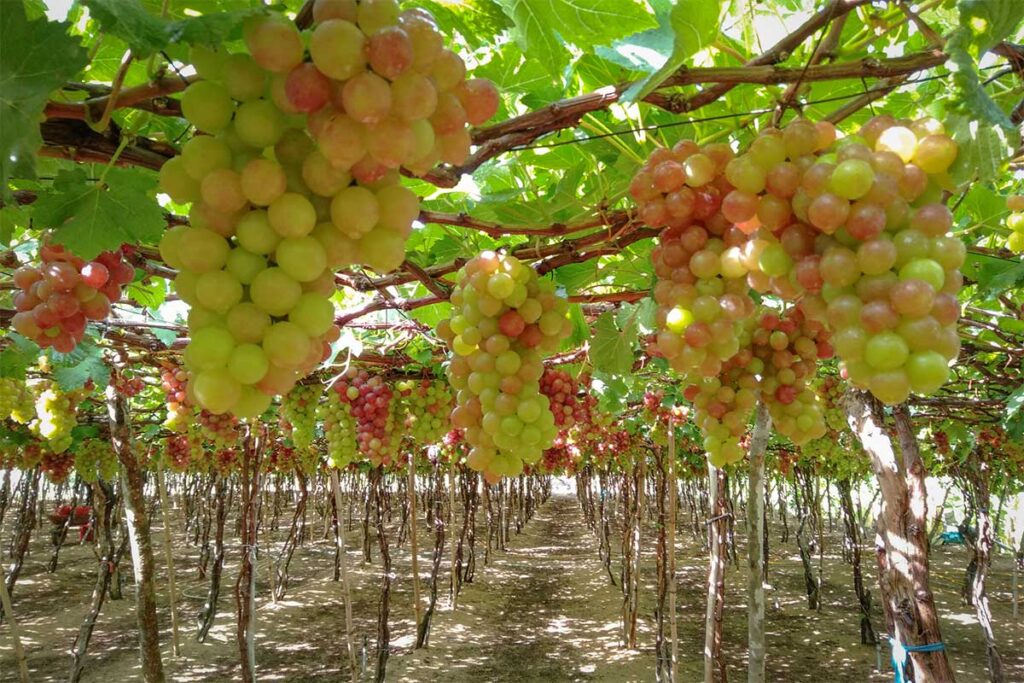
The climate in Ninh Thuan is harsh but unusually stable, with just two clear seasons: a long dry season and a shorter rainy season. These conditions, while tough for many crops, are surprisingly favorable for grapes. Vines here benefit from strong sunlight, sandy soils, and low humidity, making Ninh Thuan one of the few parts of Vietnam where grapes grow successfully on a large scale.
History and Culture
Grape cultivation in Ninh Thuan started in the 1960s and expanded rapidly in the 1980s and 1990s as local farmers discovered which varieties thrived. Today, the province has around 1,000 hectares of vineyards, with both red and green grapes widely grown.
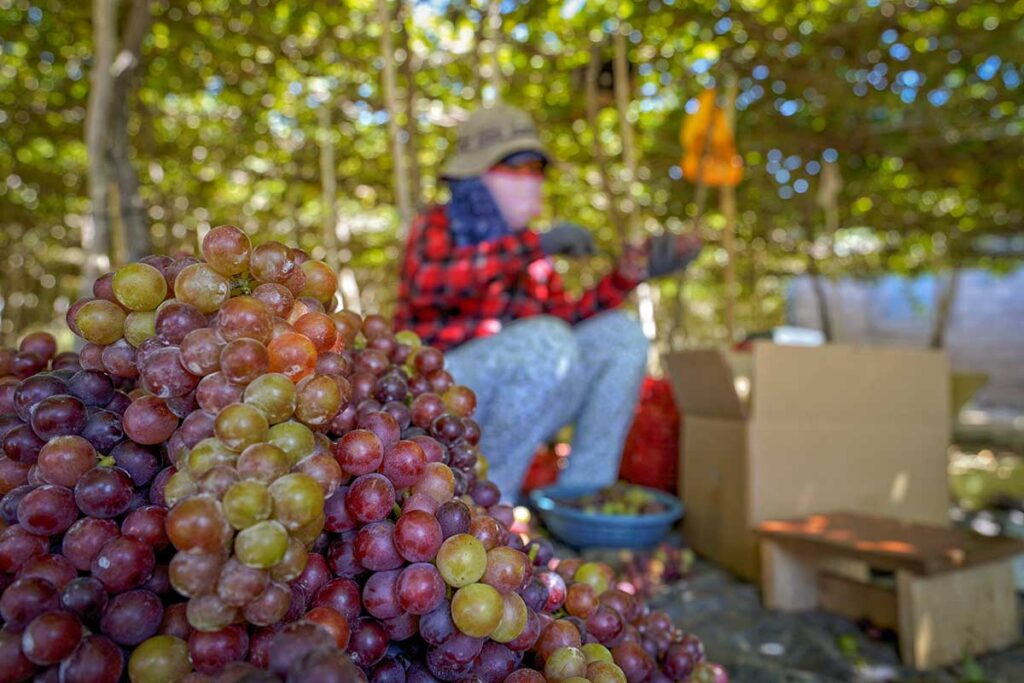
In recent years, growers have adopted VietGAP standards (Vietnamese Good Agricultural Practice) to improve quality, and some farms are experimenting with international standards and new grape varieties imported from abroad. Grapes here are used fresh, dried, or processed into juice, wine, jam, and syrup, making them an important part of the local economy.
Tourism perspective
Unlike wine estates in Europe or California, the vineyards in Ninh Thuan are small-scale, family-run plots. They don’t have polished visitor centers or wine-tasting rooms, but that’s also part of their charm. Many farms open their gates to visitors for free, often with the expectation that you buy some grapes or local products before leaving. the experience is popular with domestic tourists, especially for photos and seasonal grape-picking, but still relatively unknown among foreign travelers. Visiting a vineyard is rarely the main reason to come to Ninh Thuan, but it adds a unique, local stop alongside the province’s beaches, Cham heritage, and coastal roads.
The most famous vineyards of Ninh Thuan
While vineyards dot the region, only a handful stand out for being easy to visit, distinctive, or offering a better experience for travelers. These are the ones worth considering on your trip.
1. Ba Moi Vineyard (Vuon nho Ba Moi)

Ba Moi is the best-known vineyard close to Phan Rang, only about 7 km from the city. It is often recommended as the easiest place for foreigners to get a first taste of Ninh Thuan’s grape culture. The farm is certified under VietGAP standards, which focus on safe and sustainable farming, and grows both table grapes and wine grape varieties.

Entrance is free, and visitors are usually welcomed to taste fresh grapes, try products like syrup or jam, and sometimes even join a short tour led by the owner himself. The set-up is simple, but it’s one of the few vineyards that clearly combines grape growing with eco-tourism.
2. Thai An Vineyards (Lang nho sinh thai Thai An)
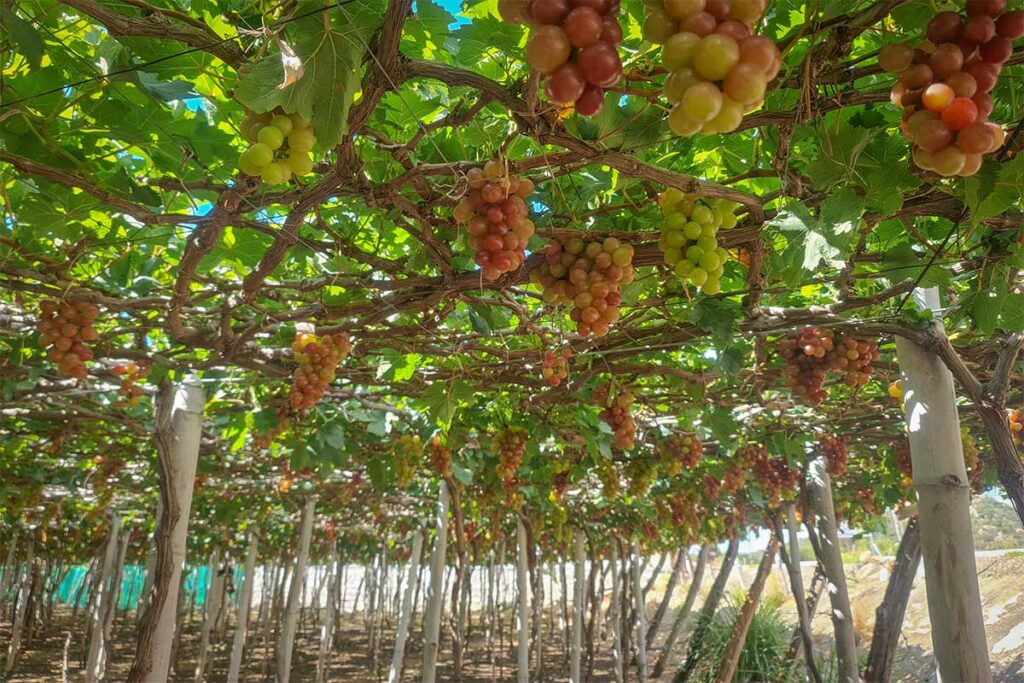
Around 25–30 km northeast of Phan Rang, Thai An is known as the “vineyard capital” of Ninh Thuan. The area has dozens of small family-run plots, many of which open their gates to visitors. It is a great stop along the coastal road to Vinh Hy Bay, both for scenery and for the variety of grape experiences. Some vineyards here allow you to pick grapes yourself when in season, while others use staggered planting so you can see vines at different stages of ripeness side by side. Each family vineyard has its own character, with simple stalls, shaded tables, and owners happy to sell you fresh grapes or homemade products.
3. Tina Thai An Vineyard (Vuon nho Tina)
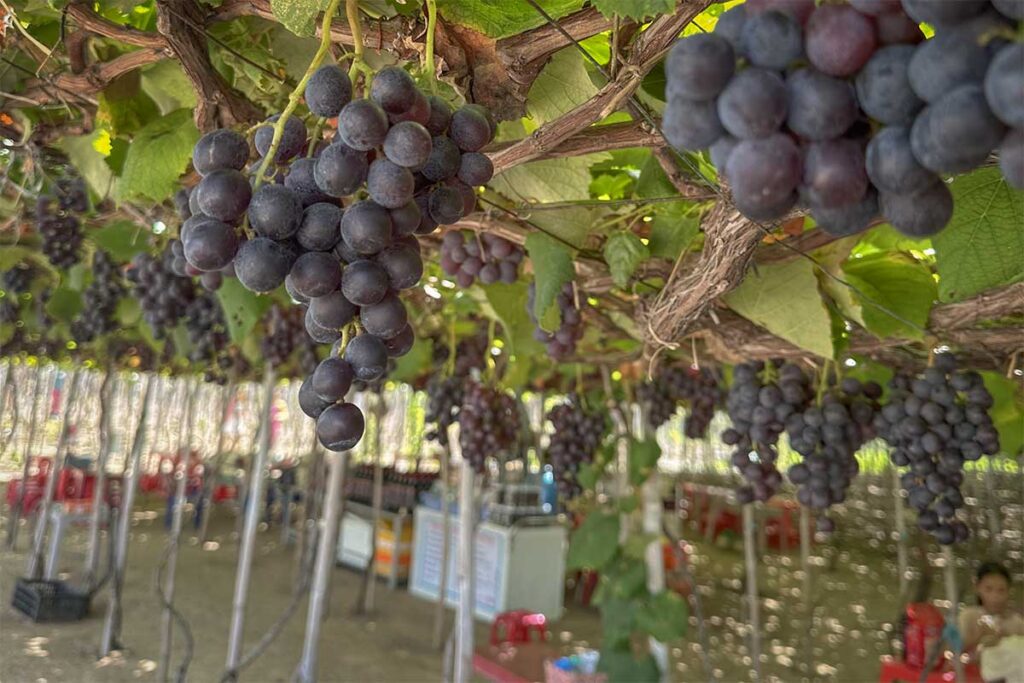
Among the vineyards in Thai An, Tina has become a favorite for photography. Located directly along the DT702 coastal road, it’s easy to stop by on a drive between Phan Rang and Vinh Hy. The vineyard is arranged in multiple planting cycles, so grapes of different colors and ripeness hang side by side, creating an especially photogenic patchwork. With tall trellises, dense vines, and good light, it is one of the more “Instagrammable” spots in the area. Most visitors only spend a short time here, but it works perfectly as a quick scenic stop.
4. Black Finger Vineyard (Nho ngon tay den)
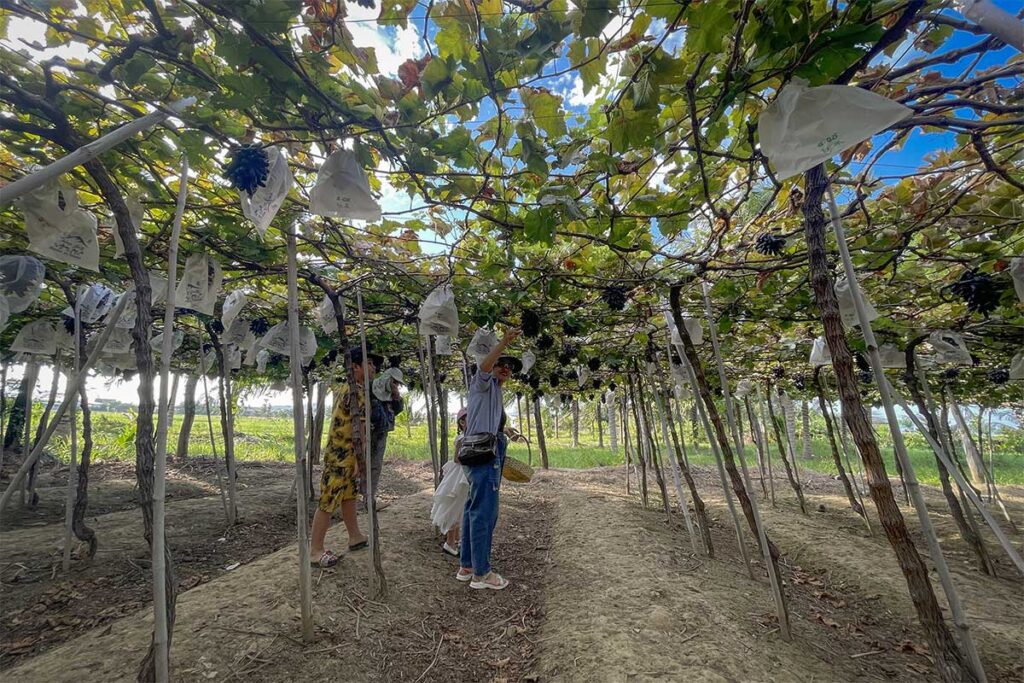
This newer vineyard has attracted attention for growing a rare type of seedless grape called “black finger,” with long, slim berries and a dark purple color. It’s not a traditional vineyard but more of a curiosity that appeals to domestic tourists looking for something different. The unusual variety makes it a popular check-in spot on social media. Like other vineyards, entry is free, and visitors can taste or buy grapes directly on site. It’s worth a stop if you want to see the more modern side of grape farming in Ninh Thuan.
5. Peony Vineyard (Nho mau don)
The Peony Vineyard is one of the newest additions to the local scene, located only about 2 km from Phan Rang city. It grows a Korean grape variety known as “peony grapes,” which are large, round, and glossy. The look of the fruit is striking, and the novelty has quickly made it popular among domestic visitors. While facilities are basic, it’s a convenient and unusual vineyard to check out if you don’t have time for the longer coastal trip to Thai An. More than anything, it highlights how local farmers are experimenting with new varieties to keep vineyard tourism interesting.
How to visit, What to Do & See
Visiting vineyards in Ninh Thuan is very different from touring polished wine estates elsewhere in the world. The experience is simple, casual, and usually short — but it can be rewarding if you know what to expect.
Where to find vineyards
The main vineyards are clustered in two areas:
- Around Phan Rang: Ba Moi Vineyard and the newer Peony Vineyard are both within a few kilometers of the city center, making them easy half-hour detours.
- Along the DT702 coastal road toward Vinh Hy: Thai An, Tina, and Black Finger Vineyards are spread along this route. The road itself is one of the most scenic drives in Vietnam, hugging the coastline with views of the sea and Nui Chua mountains.
Because of this, most visitors combine vineyard stops with nearby attractions such as Vinh Hy Bay, Nui Chua National Park, or the rocky coastline at Hang Rai.
How to visit
Most vineyards in Ninh Thuan are walk-in friendly. There is rarely any need to book ahead, and gates are usually open during the day. Entry is often free, but the unspoken rule is that you support the family by buying some grapes or local products before leaving. A typical visit lasts around 30–45 minutes and works best as part of a broader day trip rather than a standalone excursion.
What to do at vineyards
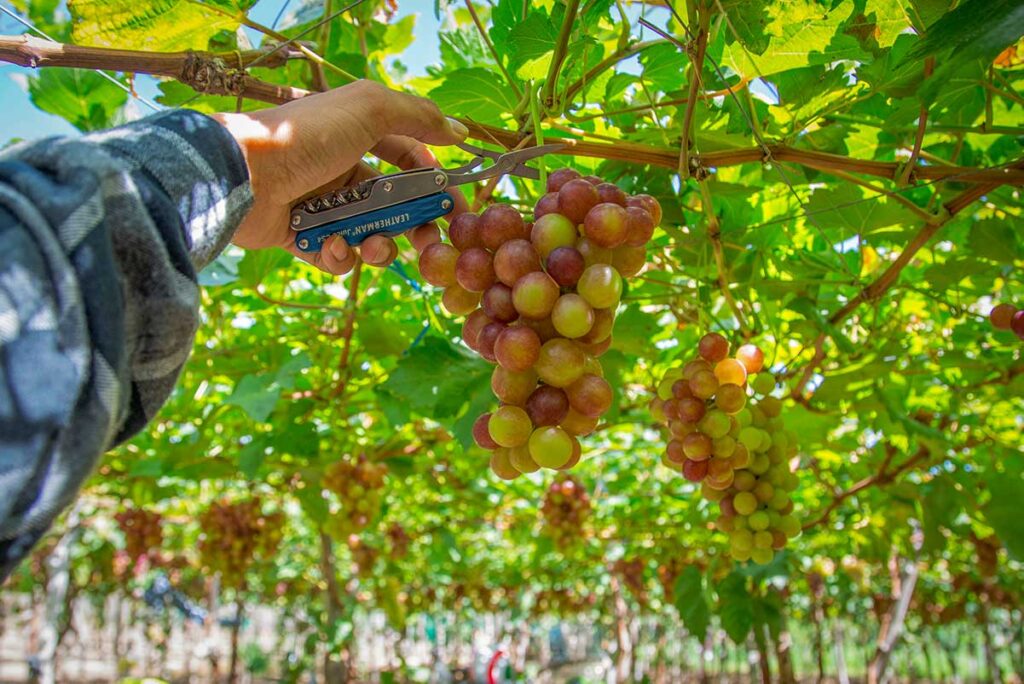
Pick grapes: Some vineyards, especially in Thai An, allow you to pick grapes directly from the vines during harvest season. This isn’t guaranteed year-round, as many vines are bare or in early growth stages outside harvest.
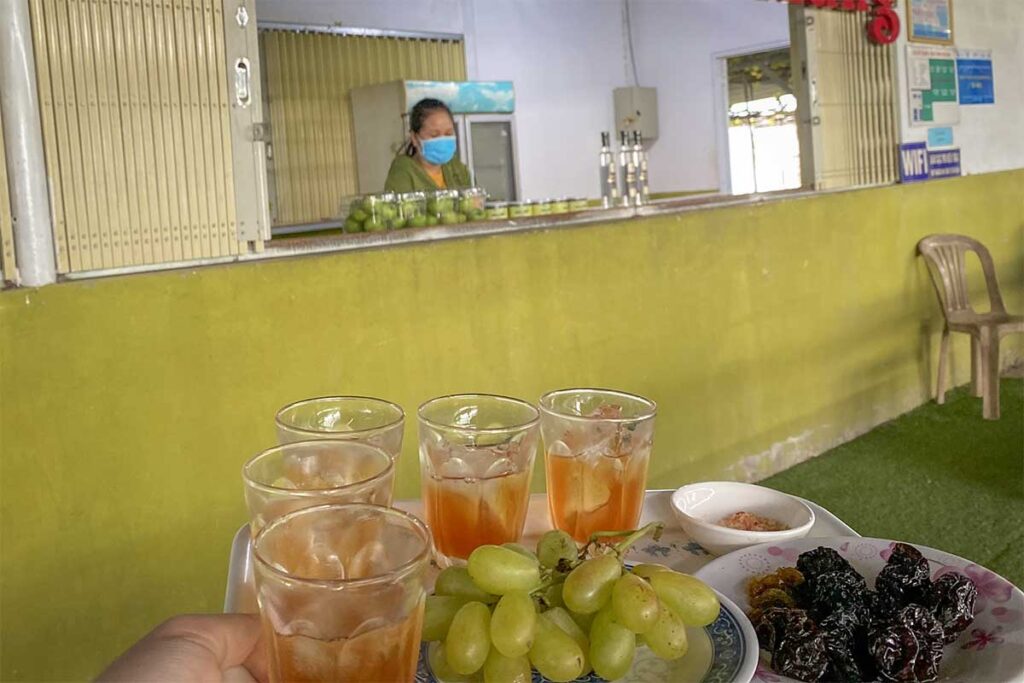
Taste local products: Nearly every vineyard offers tastings of fresh grapes, grape syrup, jam, raisins, or homemade wine. Quality varies, but it’s part of the local experience.
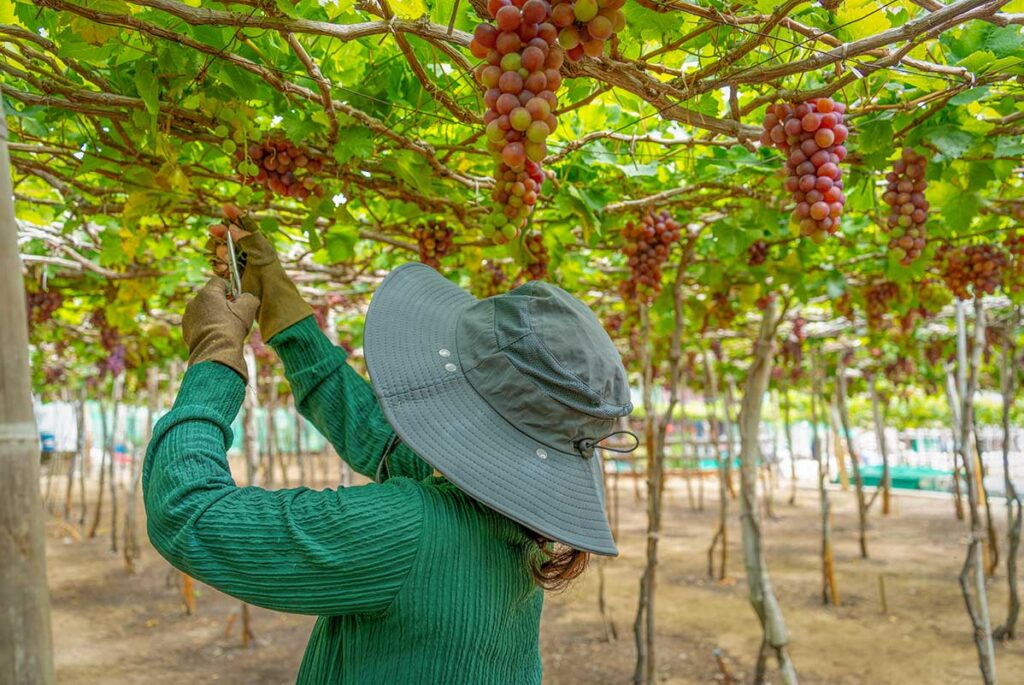
Learn about cultivation: In a few places, owners may take time to explain how grapes are grown and harvested. English explanations are limited, but the enthusiasm is clear.
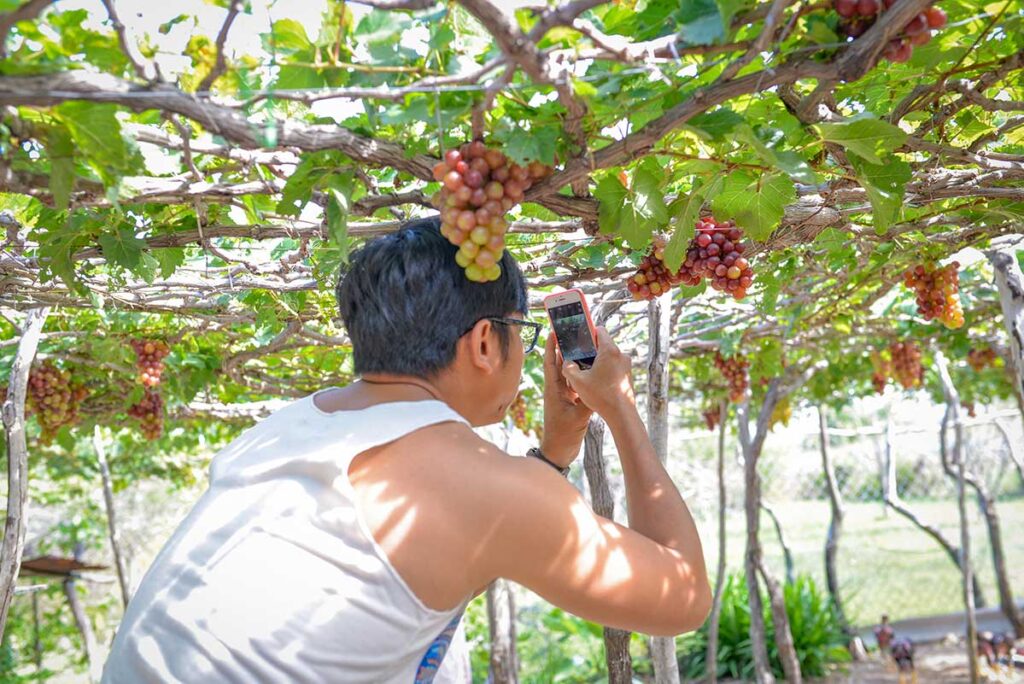
Take photos: The overhead trellises make for classic vineyard shots. Thai An and Tina vineyards are especially popular for photography.
Facilities and Reality check
Facilities at Ninh Thuan vineyards are basic. Expect plastic tables, small home-style stalls, and shaded seating rather than cafés or restaurants. English is rarely spoken, so interactions are simple — pointing, smiling, and using translation apps goes a long way. Toilets may be available but are often very basic, and only a handful of vineyards sell cold drinks or snacks. Don’t expect guided tours or wine tasting sessions like in Europe; this is more about a local glimpse into farming life. Buying a bag of grapes or a jar of jam is the best way to support the families who open their vineyards to travelers.
Best time to visit Vineyards
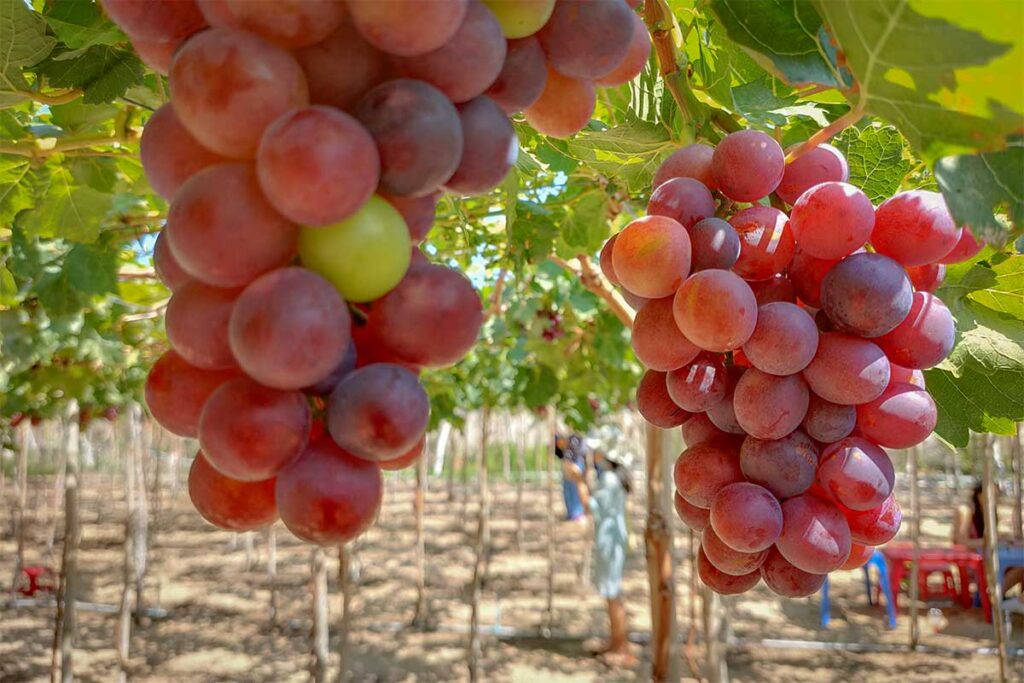
Grapes in Ninh Thuan are usually harvested twice a year, from April to June and again from August to October. These months are the most rewarding for vineyard visits, as the vines are heavy with fruit and some farms allow visitors to pick grapes directly.
Outside of harvest, the vines may look bare or only partly developed. A few farms, especially in Thai An, use staggered planting so there are always some vines with fruit, but the overall impression is less striking. If you visit in the off-season, expect fewer opportunities for grape picking and more focus on tasting products like jam or juice.
The timing also fits well with Ninh Thuan’s other attractions. April to August is both grape season and the province’s peak beach season, making it easy to combine vineyard visits with coastal trips.
Occasionally, the province organizes a Grape and Wine Festival to celebrate the harvest, featuring vineyard tours, street parades, and cultural events. The last edition was in 2019, and while it’s not an annual event, it’s worth checking if one happens to coincide with your visit.
Practical travel tips
Transport
The easiest way to reach the vineyards is by motorbike or private car with driver. Public buses don’t stop at individual farms, and taxis may not be convenient for exploring multiple stops. A vineyard visit works best as part of a loop along the coastal DT702 road or as a short side trip from Phan Rang.
Duration
Most visitors spend about half a day combining vineyards with nearby attractions. If you only visit Ba Moi or Peony near Phan Rang, it can be as quick as 30–45 minutes. For the Thai An area, plan a few hours so you can enjoy the drive and stop at other sights such as Vinh Hy Bay or Hang Rai.
Costs
Entrance is usually free, but the expectation is that you’ll buy something before leaving. Fresh grapes typically cost around 30,000–60,000 VND per kilo, depending on the variety. Products such as grape syrup, jam, or raisin packs are also common and make good souvenirs.
Etiquette
Always ask before picking grapes or taking close-up photos of vines. In most cases, owners are happy to let you sample or pick a little if it’s harvest season, but not outside those times. Buying even a small amount of fruit or products is the best way to support the families who open their vineyards to travelers.
Health note
Fresh grapes are often offered directly from the vines, but they may not be washed. Use your own discretion — some travelers are comfortable trying them, while others prefer to rinse them later or stick to packaged products.
Is visiting Ninh Thuan Vineyards worth it?
Visiting the vineyards of Ninh Thuan can be a pleasant addition to a trip, but it depends on your expectations.
- Yes, it’s worth it if you’re curious about local agriculture, enjoy photography under leafy trellises, or simply want a short cultural stop that breaks up days of beach and coastal sightseeing. The experience feels authentic and local, with families welcoming visitors into their small farms.
- Less so if you expect polished wine estates, guided tastings, or an in-depth look at winemaking. Facilities are simple, English is limited, and visits are usually short.
Overall, vineyards work best when combined with other highlights in the region. A stop at Ba Moi or Peony fits easily into a morning in Phan Rang, while the Thai An vineyards pair naturally with a drive along the scenic coastal road to Vinh Hy Bay, Cham towers, or the landscapes of Nui Chua National Park.



